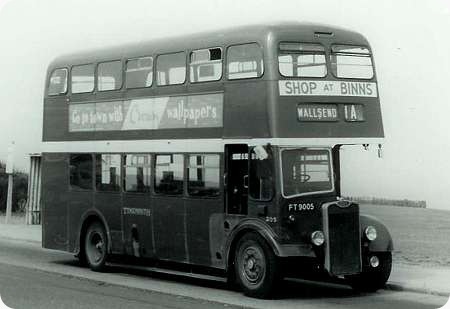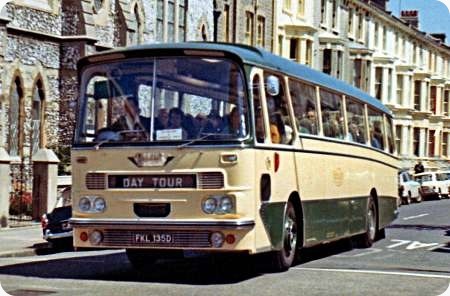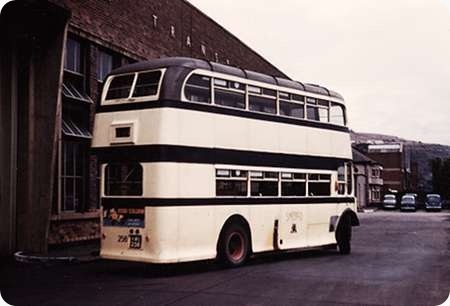
Sheffield Corporation
1948
AEC Regent III
Weymann H30/26R
The three batches of Weymann bodied AEC Regent III’s, comprising forty vehicles in all, were, to my mind at least, arguably the most attractive of all the double deckers taken into stock by Sheffield Transport Department in the immediate post-war period. The initial batch of ten, 527-536 (JWB 727/828/729-736) probably had the edge, with their half drop windows instead of the top sliders fitted to the other two deliveries of fifteen vehicles each, 558-572 (JWE 858-872) and 250-264 (KWE 250-264), one of the latter batch which is seen here. The rear ends of these buses always looked particularly attractive to me, with the well radiused top corners to the platform window, not to mention that classic of an emergency window upstairs. And of course, the outswept bottom panels of these Weymann bodies only added to their overall elegant appearance.
It was an overcast afternoon in July, 1961 when 258 was recorded on film, having just swept through the doors of Herries Road garage, about to take up service on one of the 94 group of workers services from the large Southey Green and Parson Cross housing estates to the miles of steelworks at Brightside and Templeborough. Later that same year, 258, along with sister Regents 251/2/4, were withdrawn and sold to Grimsby-Cleethorpes Transport for further service, a couple of the quartet lasting a further seven years, not being finally withdrawn from the seaside until 1968, having given a very creditable twenty year service life.
Photograph and Copy contributed by Dave Careless
04/06/13 – 18:05
The transfers became Grimsby-Cleethorpes Transport numbers 41 (KWE 258), 48 (KWE 251), 49 (KWE 252) and 50 (KWE 254). The intervening numbers 42-47 were occupied by similarly Weymann-bodied Regent IIs ex London Transport (HGC 233, 222, 227, 228, 219 and 225 respectively).
Stephen Ford
04/06/13 – 18:06
Classic AEC, classic Weymann, classic Sheffield, shear perfection; or am I prejudiced? Ah, so what?
David Oldfield
05/06/13 – 06:07
527 – 536 also didn’t have the out-swept skirt and were delivered without the smudge roof. Regrettably, I had little contact with these fine beasts as Herries buses didn’t penetrate our corner of Sheffield until the 38 was replaced by the 42/53 cross city service. Occasionally the Roberts and Cravens did rush hour duty. Where would these Weymanns have been originally? Town Head Street? [Herries Road depot was not built until 1952.]
David Oldfield
05/06/13 – 18:04
David, when they were new, the initial batch 527-536 were at Leadmill Road, and all the others went to Bramall Lane garage. I remember riding on the 558-572 batch a lot around the time I took the picture, when they were working on the Petre Street-City-Graves Park service 34, some of my most enjoyable bus rides ever!
Dave Careless
06/06/13 – 06:16
Now that you mention it, I do remember them on Graves Park 34s. [Who would have done 74s? Wasn’t there some inter-working?] I was only 8 when that picture was taken. I wasn’t let loose, on my own, on a bus for another two years – and then only under controlled circumstances.
David Oldfield
06/06/13 – 17:08
Many of these Weymanns were indeed at Bramall Lane Depot. They serviced among others, 34 Graves Park/Petre Street (Reform Chapel) which was a replacement tram route from about 1925. The AEC 111s mostly on this route were normally with Northern Coach Builders squarer profile, which I personally preferred. I preferred them because of the interior lights, (which were ribbed squarish), the top deck emergency window (shaped like a loaf of Hovis) & the fact my dad drove this route daily for many years! The route 35 to Holythorpe Rise used the Weymanns pictured. The 33 route to Hemsworth (in my time), were what I thought were AEC 111s Park Royal with nice interiors, including a 1" ish green band between windows & roof downstairs. This was my favourite at the time. Since getting back into buses, they could have been Cravens. The 36 route was a rush hour duplicate to Heeley Green. On this route you had anything with 4 wheels & an engine. This was my preferred transport to school. It could be pre-war, post war, single or double deckers. You never had the same bus 2 days running, heaven. The other route on the via Bramall Lane route was the 38 to Norton.
Andy Fisher
06/06/13 – 17:08
Upstairs front offside, of course, was always the preferred option, but a close second was the lower saloon nearside front seat, peering over into the cab and watching every action of the driver, manhandling the pre-selector lever through the gears as we bowled along the Wicker. Leaping off just before we came to a stop at Reform Chapel terminus at the Petre Street end of the route, and watching the conductor lean out and wind the blinds over the platform round to City and Hollythorpe Rise never ceased to fascinate. Happy summer days.
Dave Careless
07/06/13 – 05:50
No Park Royals between 1935 and 1955 (Monocoaches) or 1963 (Regent V front loaders). Could be Cravens but the Roberts had a more Park Royal profile. The 38 was originally Lowedges Road. It only became Norton when the 42/53 were redirected to Lowedges Road from Woodseats and Graves Park. I’m sure Bramhall Lane had closed by the time Norton took on the 38 route number. I think my favourites were Cravens and Weymann in that order. It would be another four or five years before my all time favourite (Roes) appeared for the first time. This time of year (summer) I would make a trek to the 38 (Lowedges Road) terminus at about this time (1800) to do the same, Dave. They were principally the OWE, RWB and SWE Regent IIIs – Roe, Roe and Weymann.
David Oldfield
08/06/13 – 07:56
Andy, square ribbed light fittings – yes, we had them in Nottingham too (and indeed Bartons no. 906, a second hand Leyland PD2 acquired from Yorkshire Woollen about 1961, had them as well). I’m away from home on holiday at the moment, but on my other computer at home I have a selection of "light" pictures (a strange but innocent fascination of mine!) and will post a photo when I get home.
Stephen Ford
08/06/13 – 17:50
My fascination does not stop at lights. The flat wheel rims of many buses compared to the dished ones on Leylands, (preferred) the Leyland wheel chrome rims compared to the AECs & Crossleys. The fact buses without chrome rims look awful & dated, shapes & styles of opening windows, different dashboards & last but not least rear emergency exit windows upstairs. Does this make me weird?
Andy Fisher
09/06/13 – 15:27
Andy. Weird? Not in the least. Emergency windows and wheel nut rings are the stuff of legend. For instance, not only the classic Weymann emergency window in the picture, which I referred to in the caption, but perhaps my all-time favourite, the two-piece rear upstairs window on the post-war Leyland bodies, to go along with the Leyland wheel trims to which you refer. As always, the devil is in the details. If somebody was to put out an expensive hardback volume on emergency window design, I’d be first in line to buy it. Or perhaps you would; hopefully they’d sell more than two copies.
Agreed that buses without wheel trims tend to look unfinished somehow. Oddly enough, even though LT painted both wheels and trims brown, a Routemaster with brown wheels and no wheel trims, even though they weren’t chrome, just doesn’t look right. Thank goodness the LT trolleybus department operated under a different set of rules, and maintained the chrome wheel trims on those magnificent vehicles right to the end.
Dave Careless
17/06/13 – 06:47
Just having a look in my books, both Leyland & AECs did have rear centre hub adornments, instead of the 6 or 8 nuts. The Leyland was especially nice with rings & the Leyland logo. The AECs seem to just have the AEC triangle & letters similar to the radiator badge.
Looking in my tram book, there is a picture of Haymarket from around 1936. Quite identifiable were the Weymann emergency exit, but also in the picture were rear emergency exit windows in the sausage shape windows similar to later Roes. If we did not have Roes in 1936, can anyone help me identify them please?
Andy Fisher
 Vehicle reminder shot for this posting
Vehicle reminder shot for this posting
19/06/13 – 08:00
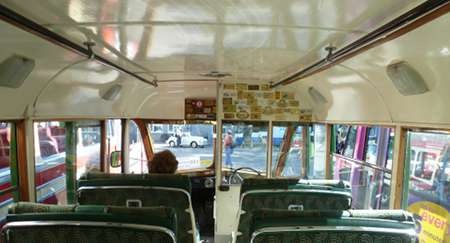
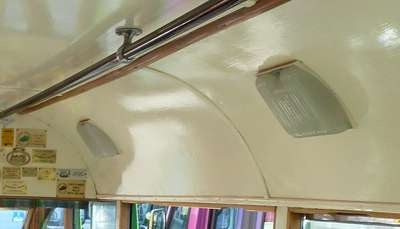
As promised, here is an interior picture showing the square fluted light fittings. Sadly these are mounted upside down (!) as they always were on Nottingham’s big fleet of 1950 trolleybuses, and the later Park Royal AEC Regents. The correct way was with the securing recess at the bottom edge – or at least, I always thought they looked more balanced that way.
Stephen Ford
19/06/13 – 14:33
Correct again Steven, these were the lights I remember. Going back to the sausage shape emergency exits, could these be Cravens or Roberts?
Andy Fisher
20/06/13 – 07:13
Either, but at at a guess more likely to be Cravens.
David Oldfield
20/06/13 – 07:15
Strange how there is a natural order of things and it’s not always the way things were designed to be! Whatever the ‘designed’ way here, I agree with you, Stephen!
Of course, you can’t argue with ’round’ which is how I recall covered lights! However, shades were always better than bare bulbs. It was always a course of annoyance to me when they took the shades off the 1938 UndergrounD stock. Each one of those must have been a time-consuming conversion, when studied.
Chris Hebbron
